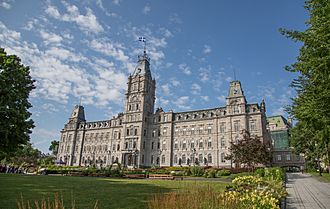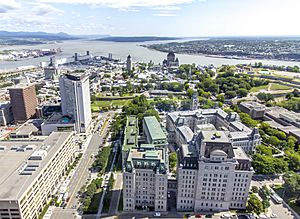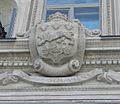Parliament Building (Quebec) facts for kids
Quick facts for kids Parliament Building |
|
|---|---|
|
Hôtel du Parlement
|
|

Parliament Building, in Quebec City
|
|
| General information | |
| Architectural style | Second Empire |
| Address | 1045 rue des Parlementaires |
| Town or city | Quebec City, Quebec |
| Country | Canada |
| Coordinates | 46°48′32″N 71°12′51″W / 46.808762°N 71.214178°W |
| Construction started | 1877 |
| Completed | 1886 |
| Client | Crown in Right of Quebec |
| Owner | Crown in Right of Quebec |
| Technical details | |
| Size | 52 metres or 171 feet in height. |
| Design and construction | |
| Architect | Eugène-Étienne Taché |
The Parliament Building (in French, Hôtel du Parlement) is a very important building in Quebec City, Canada. It's where the Parliament of Quebec meets to make laws for the province. This includes the Lieutenant-Governor of Quebec and the members of the National Assembly of Quebec. The building has eight floors and was designed by a famous architect named Eugène-Étienne Taché. It was built a long time ago, between 1877 and 1886. With its tall front tower, the building stands about 52 meters (171 feet) high. You can find it on Parliament Hill, just outside the old walls of Old Quebec. This area is part of the La Cité-Limoilou borough.
Building Style and History
The Parliament Building looks very grand because it uses a style called Second Empire architecture. This style was super popular in the late 1800s, especially in France, where it started, and also in the United States. Even though the building has a balanced design with a clock tower in the middle, which is common for British government buildings, its overall style is quite special among Canadian parliament buildings.
The front of the building, called its façade, is like a history book carved in stone. It features many sculptures that tell the story of Quebec's history. These sculptures show important events and people from the past.
Over the years, more buildings were added around the main Parliament Building to help with government work:
- Édifice André-Laurendeau was built from 1935 to 1937. It houses the Ministry of Transport.
- Édifice Honoré-Mercier was added from 1922 to 1925. It holds offices for the Treasury (Finances), the Attorney General, and the Secretary General of the National Assembly.
- Édifice Jean-Antoine-Panet was built from 1931 to 1932 for the Ministry of Agriculture.
- Édifice Pamphile-Le May was added from 1910 to 1915. It's home to the Library of the National Assembly and other government offices.
Statues of Important Figures
The Parliament Building is surrounded by many statues. The front of the Quebec National Assembly building alone has 22 statues. These sculptures honor important people from Quebec's history. They help remember the leaders, explorers, and other figures who shaped the province.
-
Robert Baldwin sculpture
-
Robert Bourassa sculpture
-
Maurice Duplessis sculpture
-
Louis-Philippe Hébert's Lord Elgin, James Bruce sculpture
-
Adelard Godbout sculpture
-
Louis-Philippe Hébert's Amerindian Family sculpture
-
Louis Jolliet sculpture
-
René Lévesque sculpture
-
Louis-Philippe Hébert's Francis de Gaston, Chevalier de Levis sculpture
-
Jacques Marquette sculpture
-
Honoré Mercier sculpture
-
Pierre Le Moyne Sieur d'Iberville sculpture
-
Louis-Philippe Hébert's James Wolfe and Marquis de Montcalm sculpture
Images for kids
-
Jean de Brébeuf and Nicolas Viel
-
Paul Chomedey de Maisonneuve (below) and the allegorical statues of Religion and Country (above)
-
Marie of the Incarnation (left) and Marguerite Bourgeoys (right)
See also
 In Spanish: Edificio del Parlamento de Quebec para niños
In Spanish: Edificio del Parlamento de Quebec para niños











































